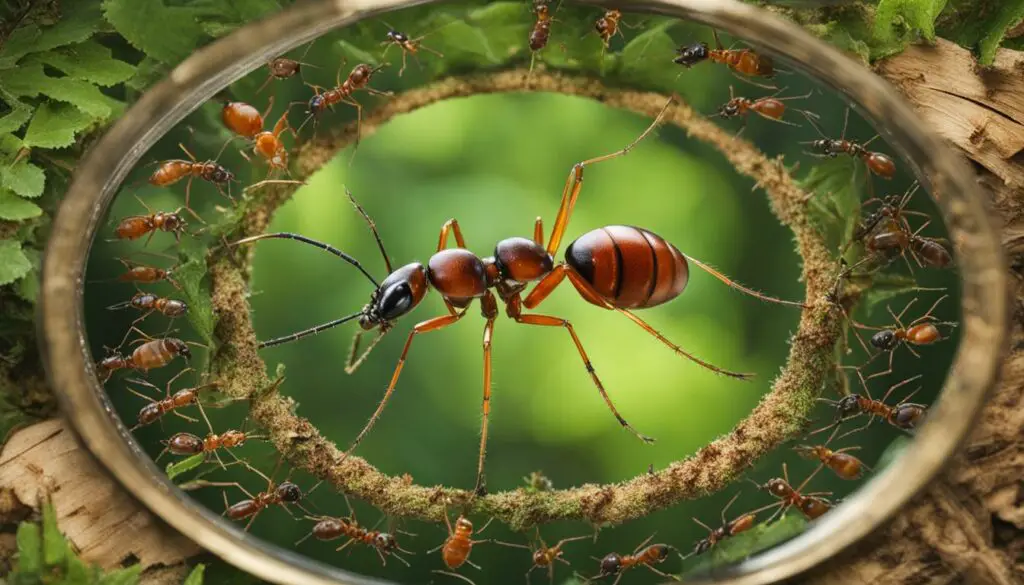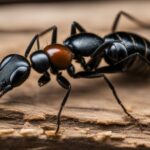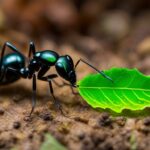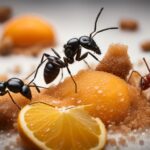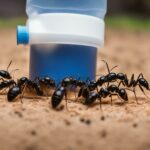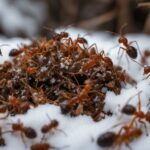Ants are a common household nuisance and can pose health and property risks. With over 700 species of ants in the United States alone, it is crucial to properly identify the ant species in order to determine the appropriate course of treatment.
Key Takeaways:
- Identifying ant species is essential for effective pest control
- Different ant species may have different habits, behaviors, and treatment methods
- Proper identification helps homeowners seek professional assistance or use specific methods to eliminate infestations
- Understanding ant characteristics, such as appearance and behavior, aids in the identification process
- Contacting a pest professional is recommended for accurate identification and treatment
The Importance of Identifying Ant Species
Identifying the species of ants infesting your home is crucial for effective pest control. Different ant species may have different habits, behaviors, and treatment methods. By correctly identifying the ant species, homeowners can seek professional assistance or use specific methods to eliminate the infestation.
One key reason for identifying ant species is understanding their behaviors. For example, some ants are attracted to sugary substances, while others prefer protein-rich food. By knowing the preference of the ant species in your home, you can strategically place baits or use targeted methods to lure and eliminate them.
Additionally, different ant species may require different extermination techniques. For instance, some ant species have multiple queens, making them more challenging to eradicate. Others may have nesting sites within walls, floors, or even electrical outlets, requiring specialized treatments to reach and eliminate them effectively.
Identifying Ant Species: Tips and Methods
Identifying ant species can be done through careful observation of their physical characteristics and behavior patterns. Here are some tips and methods to help homeowners in identifying ant species:
- Size: Measure the length of the ants to determine if they are small, medium, or large.
- Color: Observe the color of the ants, noting any distinct markings or patterns.
- Antennae: Examine the shape and length of the antennae, as they can vary between species.
- Behavior: Take note of their nesting locations, food preferences, and movement patterns.
By combining these observations, homeowners can gather valuable information that can aid in species identification. It is also helpful to consult professional pest control experts who have experience in identifying and treating different ant species.
Overall, identifying ant species is an essential step in effective pest control. By understanding the habits, behaviors, and treatment methods specific to each ant species, homeowners can take targeted actions to eliminate the infestation and prevent future invasions.
| Ant Species | Physical Characteristics | Behavior | Treatment Methods |
|---|---|---|---|
| Argentine Ants | Dark brown Found in the southeastern US |
Prefer wet environments near food sources Can contaminate food and emit a musty odor |
Eliminate food and moisture sources Use ant baits and non-repellent insecticides |
| Carpenter Ants | Reddish-black Found in cool, damp climates |
Build nests outdoors in wood sources Can cause property damage |
Locate and treat nest sites Use insecticidal dust or non-repellent sprays |
| Crazy Ants | Dark brown to black | Erratic, jerky movement when searching for food High adaptability |
Seal entry points Use non-repellent insecticides and baits |
| Odorous House Ants | Dark brown to black | Nest in soil and walls Can contaminate food and emit a coconut-like smell |
Eliminate food and water sources Use ant baits and residual sprays |
| Pavement Ants | Dark brown to black Build nests in pavement cracks |
Do not pose a health risk Can contaminate food |
Use ant baits and residual sprays Seal cracks and crevices |
| Red Imported Fire Ants | Dark reddish-brown Found in the southern US |
Build nests outdoors Can cause painful stings and allergic reactions |
Treat individual mounds or use broadcast baits Implement fire ant control programs |
Ants are fascinating insects that come in a variety of species, each with its own characteristics. Identifying the species is the first step towards effective pest control. By understanding the behavior, habits, and treatment methods specific to each ant species, homeowners can take targeted actions to eliminate the infestation and prevent future invasions.
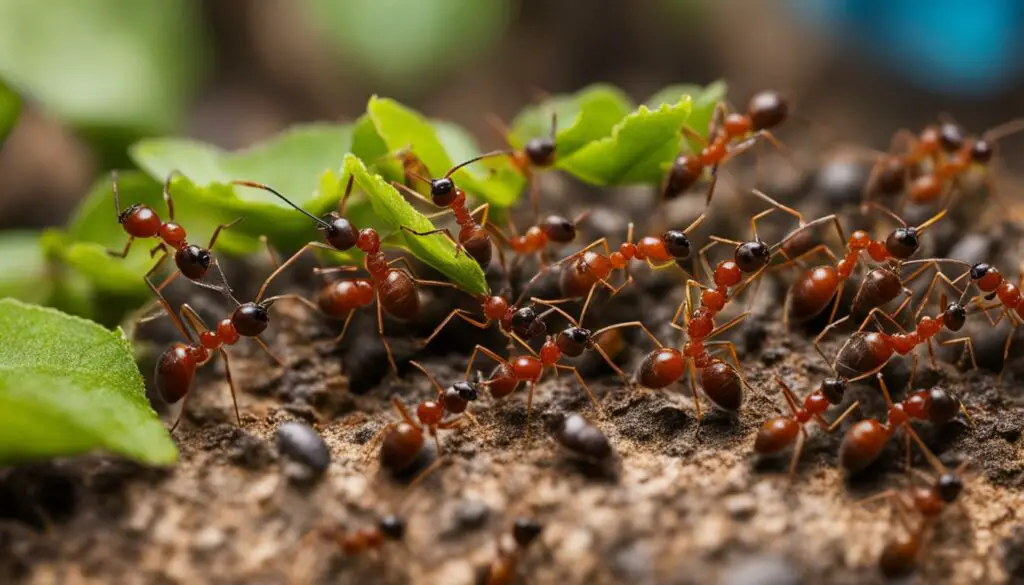
Argentine Ants
Argentine ants, also known as Linepithema humile, are a common species of ants found mainly in the southeastern United States. They typically measure around 2.2 to 2.8 mm in length and are dark brown in color. These ants are attracted to wet environments near a food source, such as kitchens, bathrooms, and gardens. Although Argentine ants do not pose a health threat to humans, they can become a nuisance by contaminating food and emitting a musty odor when crushed.
Argentine ants are known for their colony structure and aggressive behavior. They form huge supercolonies, consisting of multiple nests that work together as a single unit. This behavior allows them to dominate their habitat and outcompete other ant species. Due to their adaptive nature, Argentine ants have also spread to other regions beyond their native range, becoming a global invasive species.
To control an Argentine ant infestation, it is important to eliminate their food sources and seal off any entry points into your home. Cleaning up spills promptly, storing food properly, and reducing moisture in and around your house can help deter these ants. If the infestation persists, it is recommended to seek professional pest control services that can provide effective treatment options.
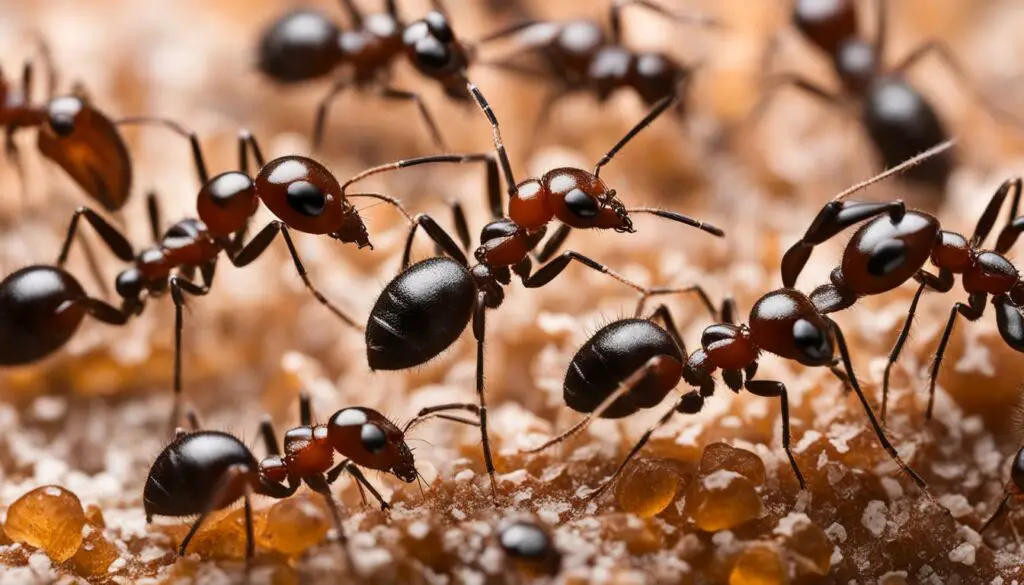
Table: Comparison of Argentine Ants with Other Common Ant Species
| Ant Species | Color | Habitat | Behavior | Health Threat |
|---|---|---|---|---|
| Argentine Ants | Dark brown | Wet environments near food sources | Form supercolonies, emit musty odor when crushed | No direct health threat |
| Carpenter Ants | Reddish-black | Cool, damp climates | Build nests in wood, can cause property damage | No direct health threat |
| Crazy Ants | Dark brown to black | Adaptable, found throughout the United States | Erratic, jerky movement when searching for food | No direct health threat |
| Odorous House Ants | Dark brown to black | All regions of the United States | Nest in soil, can nest in walls and floors | No direct health threat |
| Pavement Ants | Dark brown to black | Build nests in or under cracks in pavement | No direct health threat | No direct health threat |
| Red Imported Fire Ants | Dark reddish-brown | Southern United States | Build nests outdoors, known for painful stings | Can cause allergic reactions |
Carpenter Ants
Carpenter ants are a species of ant that can cause significant damage to homes and other structures. These ants are reddish-black in color and typically measure between ¼ and ½ inch in length. They are commonly found in cool, damp climates and build nests outdoors in wood sources. However, they can also enter buildings by tunneling through damaged wood. It is important to properly identify carpenter ants in order to determine the appropriate course of action for control and prevention.
Carpenter ants are often mistaken for termites due to their habits of tunneling through wood. However, there are key differences between the two pests. While termites eat wood for sustenance, carpenter ants do not consume wood but rather excavate it to create galleries for nesting. These galleries can weaken the structural integrity of the wood over time, leading to potential damage if left untreated.
“Carpenter ants can cause property damage as they tunnel through wood to build nests.”
To identify a carpenter ant infestation, look for the following signs:
- Presence of large, winged ants (known as swarmers) indoors or near the structure
- Piles of sawdust-like material (called frass) near damaged wood
- Rustling noises coming from inside walls or other wooden structures
- Visible damage to wood, including smooth tunnels or galleries
If you suspect a carpenter ant infestation in your home, it is recommended to contact a pest control professional for proper identification and treatment. They can inspect the property, locate the source of the infestation, and develop a targeted plan for control and prevention. Taking swift action is vital to minimize the risk of further damage and ensure the safety and integrity of your home.
Table: Comparison of Carpenter Ants and Termites
| Characteristics | Carpenter Ants | Termites |
|---|---|---|
| Color | Reddish-black | Light brown to white |
| Body Shape | Segmented body with pinched waist | Straight, elongated body with no distinct waist |
| Antennae | Bent or elbowed | Straight |
| Wings | Front wings larger than hind wings | Equal-sized wings |
| Feeding Habits | Do not consume wood | Feed on wood for sustenance |
| Damage | Tunnel through wood to create nests | Eat wood, causing structural damage |
Crazy Ants: Identifying Ants with Erratic Behavior
Crazy ants, also known as Tawny crazy ants or Raspberry crazy ants, are a species of ant known for their unique and erratic behavior. These ants are dark brown to black in color and measure about 1/8 inch in length. They are highly adaptable and can be found throughout the United States.
What sets crazy ants apart from other ant species is their jerky and unpredictable movement when searching for food. They move in a rapid and erratic manner, which can be quite fascinating to observe. This behavior has earned them the nickname “crazy ants.”

While crazy ants do not pose a direct health threat, they can become a nuisance if they gain entry to a structure. They are known to infest homes, particularly during the warmer months when they are actively foraging for food. These ants can contaminate food and are attracted to sweet substances, such as sugar and syrup.
When dealing with a crazy ant infestation, it is important to implement proper ant control measures. This may include sealing off entry points, removing potential food sources, and using ant baits or professional-grade insecticides. Seeking the assistance of a pest control professional is recommended for effective and long-term management of crazy ants.
Table: Comparison of Common Ant Species
| Ant Species | Color | Size | Behavior |
|---|---|---|---|
| Argentine Ants | Dark brown | 1/8 inch | Tend to form large colonies |
| Carpenter Ants | Reddish-black | 1/4 to 1/2 inch | Build nests in wood |
| Crazy Ants | Dark brown to black | 1/8 inch | Erratic movement, rapid foraging |
| Odorous House Ants | Dark brown to black | 1/8 inch | Produce a strong, coconut-like odor when crushed |
| Pavement Ants | Dark brown to black | 1/8 inch | Build nests in pavement cracks |
Remember, it is always important to correctly identify the ant species before implementing any control measures. This ensures that the most effective and targeted approach is used to eliminate the infestation. If you are unsure about the type of ants you are dealing with, consult a pest control professional for accurate identification and advice.
Odorous House Ants
Odorous house ants, also known as Tapinoma sessile, are a common type of ant found in all regions of the United States. They are small in size, measuring about 2.4 to 3.3 mm in length, and are dark brown to black in color. These ants get their name from the strong, unpleasant odor they emit when crushed, which is often described as resembling the smell of coconut.
Unlike carpenter ants that cause structural damage, odorous house ants do not pose a direct threat to buildings. However, they can be a nuisance when they infest homes. They typically make their nests in soil, but can also nest in walls and floors, especially in areas where moisture is present. Their ability to establish multiple colonies within a home can make them difficult to eliminate without professional assistance.
To prevent infestations of odorous house ants, it is important to keep your home clean and free of food sources. Seal cracks and gaps in walls and windows, fix any leaks or plumbing issues, and store food in airtight containers. If you suspect an infestation, it is best to contact a pest control professional who can identify the species and recommend the most effective treatment method.

Overall, odorous house ants may not cause structural damage, but their presence can be a nuisance and their ability to establish multiple colonies can make them challenging to eliminate. Taking proactive measures to prevent infestations and seeking professional help when needed can help homeowners effectively control these ants and maintain a pest-free home.
Pavement Ants
Pavement ants are a common species of ant that can be found throughout the United States. They are dark brown to black in color and get their name from their habit of building nests in or under cracks in pavement. These ants do not pose a health risk to humans but can contaminate food if they have access to it.
Identifying pavement ants is relatively easy. They are small in size, measuring about 1/8 inch long. They have a segmented body with a distinct head, thorax, and abdomen. Pavement ants also have antennae, which help them navigate their surroundings and communicate with other ants.
If you suspect that you have a pavement ant infestation in your home, it is important to take action to prevent further issues. You can start by sealing any cracks or gaps in your home’s foundation or pavement to prevent ants from entering. Regularly cleaning up food crumbs and spills, as well as storing food properly, can also help deter ants from infesting your home.
| Characteristics | Pavement Ants |
|---|---|
| Color | Dark brown to black |
| Size | Approximately 1/8 inch long |
| Habitat | Nests in or under cracks in pavement |
| Health Risk | Contamination of food |
“Pavement ants are small and dark-colored, often found in cracks in pavement. While they do not pose a health risk, they can contaminate food if given the opportunity. Taking preventive measures, such as sealing cracks and keeping a clean environment, can help prevent pavement ant infestations.”
If your pavement ant infestation persists or becomes unmanageable, it is recommended to seek professional help. Pest control experts have the knowledge and tools to effectively eliminate ant colonies and prevent future infestations.

The Red Imported Fire Ants: A Sting You Don’t Want to Encounter
Red imported fire ants (Solenopsis invicta) are a species of ants that can cause painful stings and allergic reactions. These ants are dark reddish-brown in color and are commonly found in the southern United States. They build their nests outdoors and can gain entry to buildings through holes or cracks, making them a nuisance for homeowners. It is important to be able to identify these ants to avoid any unfortunate encounters.
Red imported fire ants are known for their aggressive behavior and their painful stings, which can cause a burning sensation that lasts for several minutes. In some cases, individuals may experience severe allergic reactions to these ant stings, which can include symptoms such as difficulty breathing, dizziness, and swelling. It is crucial to seek medical attention if you suspect an allergic reaction to a fire ant sting.
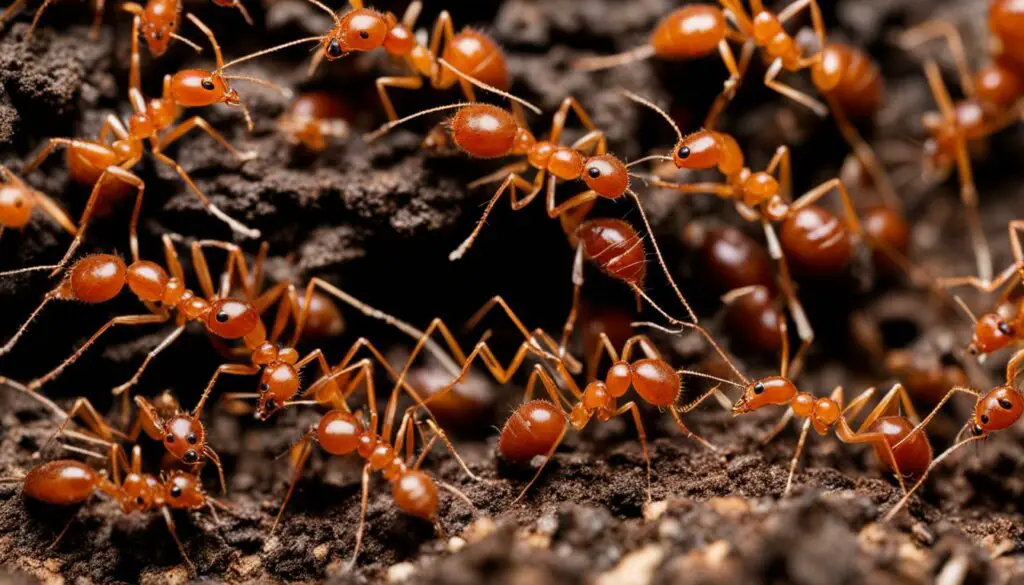
Fire ants are highly adaptable and can quickly establish large colonies. They are aggressive in defending their nests and will attack anything that disturbs them. Their stings can be incredibly painful and can result in the formation of pus-filled blisters. It is important to take precautions to avoid fire ant infestations and to seek professional help if an infestation occurs.
To prevent red imported fire ant infestations, it is recommended to keep your surroundings clean and free of food debris. Ensure that all garbage is properly sealed and disposed of regularly. Seal any cracks or openings in your home to prevent these ants from entering. If you suspect an infestation, it is best to contact a pest control professional who can identify the ant species and recommend the appropriate treatment options.
| Red Imported Fire Ants | Identification | Characteristics |
|---|---|---|
| Pest Type | Common Household Pest | Dark reddish-brown color |
| Behavior | Aggressive | Painful stings |
| Prevention Tips | Keep surroundings clean and free of food debris | Seal cracks and openings in the home |
| Treatment | Professional pest control assistance | Identification and appropriate treatment methods |
Ant Identification – What Do Ants Look Like?
Ants come in various shapes, sizes, and colors. Knowing how to identify ants based on their physical characteristics can help homeowners determine the appropriate treatment method. Here are some key features to look for when identifying ant species:
Ant Body Regions
Ants have three distinct body regions – head, thorax, and abdomen. The head houses their mouthparts and sensory organs, while the thorax connects the head to the abdomen. The abdomen contains the ant’s digestive system and reproductive organs. Additionally, ants have two pairs of antennae that they use for communication and sensory perception.
Size and Color
Ants can vary in size and color, depending on the species. Some ants are tiny, measuring a few millimeters in length, while others can be larger, reaching up to an inch in size. Furthermore, ants can range in color from black and brown to red and yellow. These variations in size and color can provide valuable clues when trying to identify specific ant species.
Behavior and Nesting Habits
Different ant species exhibit distinct behaviors and nesting habits. Some ants, like pavement ants, build their nests in or under cracks in pavement, while others, like carpenter ants, create nests in wood sources. Understanding the behavior and nesting preferences of the ants infesting your home can help in accurately identifying the species and implementing appropriate control measures.
| Species | Size (Approximate) | Color | Behavior |
|---|---|---|---|
| Argentine Ants | 2.2-2.8 mm | Dark brown | Prefer wet environments near food sources, emit a musty odor when crushed |
| Carpenter Ants | 6-13 mm | Reddish-black | Build nests in cool, damp climates, tunnel through wood |
| Crazy Ants | 2.2-3.8 mm | Dark brown to black | Erratic, jerky movement while searching for food |
| Odorous House Ants | 2.4-3.3 mm | Dark brown to black | Nest in soil, emit a coconut-like smell when crushed |
| Pavement Ants | 2.5-4 mm | Dark brown to black | Build nests in or under cracks in pavement |
| Red Imported Fire Ants | 2-6 mm | Dark reddish-brown | Painful stings, allergic reactions in some individuals |
By observing these features and consulting resources such as ant species identification guides, homeowners can gain a clearer understanding of the ants infesting their homes. This knowledge can help in implementing targeted treatment methods and effectively controlling ant infestations.
Ant Control and Extermination Information
If you suspect an ant infestation in your home, it is important to take immediate action to prevent further damage. Ants can contaminate food, cause property damage, and even pose health risks in some cases. Here are some key steps to effectively control and exterminate ants:
Identification
The first step in ant control is accurately identifying the species infesting your home. Different ant species may require different treatment methods. Hiring a professional pest control service is highly recommended as they have the expertise to identify the species and provide tailored solutions.
Inspection
A thorough inspection of your property is essential to locate ant nests and determine the extent of the infestation. Professional exterminators will conduct a detailed examination of your home, both indoors and outdoors, to identify entry points and nesting sites.
Treatment
Based on the species and severity of the infestation, a pest control expert will recommend the most suitable treatment method. This may involve baiting, spraying insecticides, or implementing other targeted strategies to exterminate the ants effectively. It is crucial to follow the professional’s instructions and take necessary precautions during the treatment process.
| Treatment Method | Description |
|---|---|
| Baiting | This method involves placing ant bait stations to attract ants, which they carry back to the colony, ultimately eradicating the entire nest. |
| Insecticide Spraying | Insecticides can be sprayed directly on ants or applied to their trails and entry points. This method is effective for immediate control but may require repeated applications. |
| Crack and Crevice Treatment | Sealing cracks and crevices with a suitable insecticide prevents ant entry and disrupts their movement within the structure. |
| Natural Remedies | In some cases, natural remedies such as white vinegar, lemon juice, or essential oils may help repel ants, but they are not a substitute for professional treatment. |
After the initial treatment, follow-up visits may be necessary to ensure the infestation is completely eliminated. Additionally, pest control experts can provide recommendations for preventive measures to minimize the risk of future ant problems.
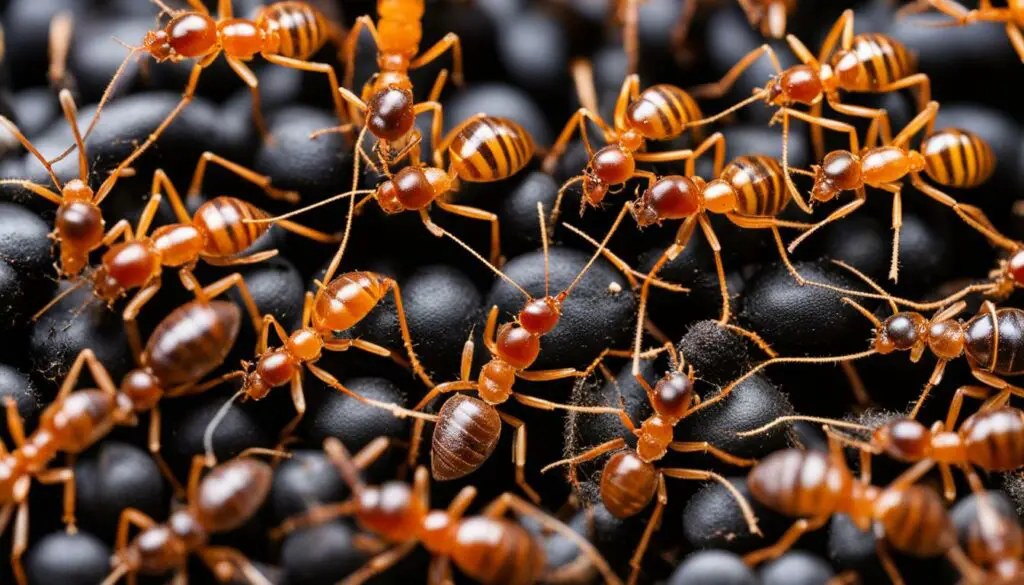
Remember, DIY ant control methods may offer temporary relief, but professional assistance is the best way to ensure long-term and effective ant extermination. Don’t hesitate to contact a reputable pest control service to safeguard your home from these persistent pests.
How to Get Rid of Ants in the House
If you’re dealing with an ant infestation in your home, it’s essential to take swift action to get rid of them. Ants can contaminate your food and cause property damage, so it’s best to address the problem as soon as possible. Here are some effective methods to eliminate ants from your house:
- Seal Cracks and Crevices: Ants can enter your home through even the tiniest openings. Seal any cracks and crevices in your walls, windows, doors, and foundation to prevent them from gaining access.
- Dispose of Garbage Regularly: Make sure to empty your garbage cans frequently and secure the lids tightly. Ants are attracted to food waste, so keeping your garbage area clean and free of crumbs is crucial.
- Clean Up Spills Promptly: Any spills or crumbs left behind can attract ants. Clean up spills immediately and wipe down countertops, tables, and floors regularly to eliminate food sources.
- Store Food Properly: Ants are relentless in their pursuit of food. Store your food in airtight containers to prevent ants from smelling and accessing it.
- Eliminate Excess Moisture: Ants are attracted to moisture, so fix any leaks or areas of excessive moisture in your home. Keep your bathroom and kitchen dry and well-ventilated.
- Remove Potential Nesting Sites: Clear away any debris, woodpiles, or clutter in and around your property. These areas can serve as attractive nesting sites for ants.
Implementing the above strategies can help you significantly reduce the ant population in your home. However, if the infestation persists or if you’re dealing with a particularly stubborn species of ants, it’s recommended to seek professional help for effective ant control.
Remember, prevention is the key to keeping your home ant-free. By taking proactive measures to secure your home and eliminate potential food and water sources, you can minimize the chances of an ant infestation in the future.
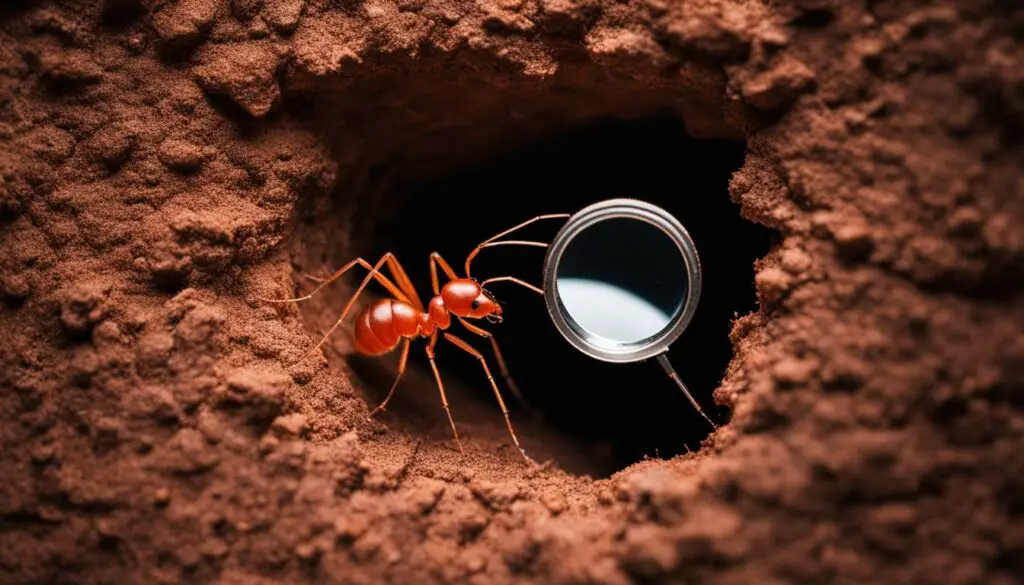
Table: Common Ant Species and Characteristics
| Ant Species | Color | Preferred Habitat | Health Risks |
|---|---|---|---|
| Argentine Ants | Dark brown | Wet environments near food sources | Contamination of food, musty odor when crushed |
| Carpenter Ants | Reddish-black | Cool, damp climates | Property damage as they tunnel through wood |
| Crazy Ants | Dark brown to black | Adaptable, found throughout the United States | Potential nuisance if they gain entry to a structure |
| Odorous House Ants | Dark brown to black | All regions of the United States | Contamination of food, coconut-like odor when crushed |
| Pavement Ants | Dark brown to black | In or under cracks in pavement | Contamination of food |
| Red Imported Fire Ants | Dark reddish-brown | Southern United States | Painful stings, potential allergic reactions |
Different Types of Ants
Ants are fascinating creatures that come in a variety of species, each with its own unique characteristics. Understanding the different types of ants can be crucial in identifying and dealing with an infestation. Let’s take a closer look at some common ant species and their distinguishing features.
Argentine Ants
The Argentine ant is a dark brown ant species commonly found in the southeastern United States. They are attracted to wet environments near a food source and can contaminate food if left unchecked. When crushed, they emit a musty odor. Despite not posing a direct health risk, Argentine ants can become a nuisance in homes.
Carpenter Ants
Carpenter ants are reddish-black ants typically found in cool, damp climates. They build their nests outdoors in wood sources but can enter buildings through damaged wood. Unlike termites, carpenter ants do not consume wood but can cause structural damage as they excavate tunnels for their nests.
Crazy Ants
Crazy ants are dark brown to black in color and have a distinctive jerky movement when searching for food. They are highly adaptable and can be found throughout the United States. While they do not pose a direct health threat, they can be a nuisance if they gain entry to a structure.
These are just a few examples of the wide variety of ant species that exist. By being able to identify the different types of ants, homeowners can better understand their behaviors and habits, allowing for more effective pest control and prevention measures.
Conclusion
Having a comprehensive ant species identification guide is crucial for effective pest control in your home. With over 700 species of ants in the United States alone, it is important to correctly identify the species infesting your property to determine the best treatment method.
By understanding the characteristics, habits, and behaviors of different ant species, you can take proactive measures to prevent infestations and eliminate existing ones. Knowing what ants look like and their specific traits can help you identify the species and seek professional assistance for accurate identification and treatment.
Remember, if you suspect an ant infestation, it is always recommended to contact a pest professional. They have the expertise to inspect your home, identify the ant species, and recommend the most effective course of action to control and eliminate the infestation.
With the right ant species guide and proper identification methods, you can ensure a safe and pest-free home environment for you and your family.
FAQ
Why is it important to identify the species of ants in my home?
Different ant species may have different habits, behaviors, and treatment methods. By correctly identifying the ant species, homeowners can seek professional assistance or use specific methods to eliminate the infestation.
How can I identify Argentine ants?
Argentine ants are dark brown and found mainly in the southeastern United States. They prefer wet environments near a food source. While they do not pose a health threat, they can contaminate food and emit a musty odor when crushed.
What damage can carpenter ants cause?
Carpenter ants are reddish-black in color and usually found in cool, damp climates. They build nests outdoors in wood sources and can enter buildings through damaged wood. Carpenter ants can cause property damage as they tunnel through wood to build nests.
How can I identify crazy ants?
Crazy ants are dark brown to black with an erratic, jerky movement when searching for food. They are highly adaptable and can be found throughout the United States. While they do not pose a health threat, they can become a nuisance if they gain entry to a structure.
What are odorous house ants?
Odorous house ants are dark brown to black in color and commonly found in all regions of the United States. They make their nests in soil and can nest in walls and floors inside homes. While they do not cause structural damage, they can contaminate food and emit a coconut-like smell when crushed.
How do I identify pavement ants?
Pavement ants are dark brown to black and get their name from building nests in or under cracks in pavement. They do not pose a health risk but can contaminate food. Pavement ants are found throughout the United States.
What are red imported fire ants?
Red imported fire ants are dark reddish-brown in color and found in the southern United States. They build their nests outdoors and can gain entry to buildings through holes or cracks. These ants are known for their painful stings and can cause allergic reactions in some individuals.
How can I identify ants based on their appearance?
Ants have three distinct body regions – head, thorax, and abdomen, as well as antennae. While they may look similar, different ant species can vary in size, color, and behavior. Knowing how to identify ants based on these characteristics can help homeowners determine the appropriate treatment method.
What should I do if I suspect an ant infestation?
If you suspect an ant infestation in your home, it is important to contact a pest professional for proper identification and treatment. Ant control methods may differ depending on the species. Professional exterminators can inspect the home, identify the ant species, and recommend the best course of action.
How can I keep my home ant-free?
To keep your home ant-free, seal cracks and crevices, dispose of garbage regularly, clean up spills promptly, store food properly, eliminate excess moisture, and remove potential nesting sites. If an infestation occurs, it is best to seek professional help for effective ant control.

